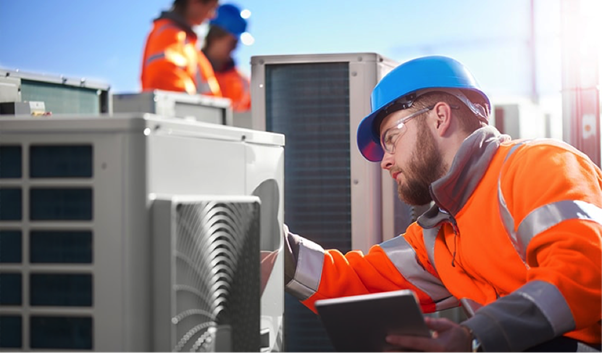
In the competitive landscape of modern business, maintaining an optimal indoor environment is crucial for productivity and employee comfort. Commercial HVAC services play a pivotal role in achieving this balance, ensuring that heating, ventilation, and air conditioning systems operate at peak efficiency. Understanding and implementing key considerations in commercial HVAC services can significantly impact operational costs, system longevity, and overall building performance.
1. Assessing System Requirements
A comprehensive assessment of your commercial HVAC system is the foundation for maximizing efficiency. This involves evaluating the size and layout of the building, the number of occupants, and the specific heating and cooling needs. Accurate load calculations help in selecting appropriately sized equipment, which is essential for preventing inefficiencies such as short-cycling or overworking of the system. Working with experienced commercial HVAC service providers ensures that these assessments are conducted with precision, leading to a more tailored and efficient system design.
2. Regular Maintenance and Inspections
Regular maintenance is crucial for the longevity and efficiency of commercial HVAC systems. Routine inspections help in identifying potential issues before they escalate into major problems. This includes checking and replacing filters, cleaning coils, and ensuring that all components are functioning correctly. Scheduled maintenance by a qualified commercial HVAC service provider not only improves system performance but also extends the life of the equipment. Proactive maintenance can reduce the likelihood of unexpected breakdowns and costly repairs, thereby optimizing overall efficiency.
3. Upgrading to Energy-Efficient Equipment
Investing in energy-efficient HVAC equipment can offer substantial long-term savings. Modern systems come with advanced technologies designed to enhance energy efficiency, such as variable-speed motors, programmable thermostats, and advanced heat exchangers. These features contribute to lower energy consumption and reduced operating costs. When considering upgrades, consult with commercial hvac services to evaluate options that align with your specific needs and budget. Energy-efficient systems not only improve efficiency but also support sustainability goals by reducing the building’s carbon footprint.
4. Implementing Building Automation Systems
Building automation systems (BAS) are instrumental in enhancing the efficiency of commercial HVAC services. BAS allows for centralized control of heating, cooling, and ventilation systems through a user-friendly interface. This integration facilitates real-time monitoring and adjustment of system settings based on occupancy patterns, outdoor weather conditions, and energy usage. By leveraging BAS, businesses can achieve optimal comfort while minimizing energy waste. Collaborating with commercial HVAC service professionals to integrate a BAS ensures that the system is configured to meet your operational requirements and efficiency goals.
5. Ensuring Proper Insulation and Sealing
Effective insulation and sealing are essential for maintaining the efficiency of HVAC systems. Poor insulation can lead to significant heat loss in the winter and excessive heat gain in the summer, forcing the HVAC system to work harder. Proper insulation of ducts, pipes, and building envelopes helps in maintaining consistent indoor temperatures and reducing the workload on the HVAC system. Additionally, sealing any gaps or leaks in the building envelope prevents conditioned air from escaping, thereby enhancing overall system efficiency. Commercial HVAC services often include assessments of insulation and sealing to identify areas for improvement.
6. Optimizing Ventilation
Proper ventilation is critical for maintaining indoor air quality and ensuring the efficiency of HVAC systems. An effective ventilation strategy involves balancing the amount of fresh air introduced into the building with the removal of stale air. This balance is essential for preventing issues such as excessive humidity or indoor pollutants, which can negatively impact both comfort and system performance. Commercial HVAC services can assist in designing and implementing ventilation solutions that meet regulatory standards and enhance indoor air quality.
7. Training and Educating Staff
Educating facility managers and staff about best practices for operating and maintaining HVAC systems can contribute to overall efficiency. Proper training ensures that staff are aware of how to adjust settings, recognize potential issues, and perform basic maintenance tasks. Additionally, fostering a culture of energy awareness among employees can lead to more conscious use of HVAC systems, further optimizing efficiency. Commercial HVAC services often provide training and resources to support ongoing education and effective system management.
8. Monitoring and Analyzing Performance
Continuous monitoring and analysis of HVAC system performance are vital for maintaining efficiency over time. Advanced monitoring tools and analytics allow for the tracking of key performance indicators such as energy consumption, system uptime, and operational efficiency. Regular analysis of this data helps in identifying trends and areas for improvement. Engaging with commercial HVAC services that offer performance monitoring solutions can provide valuable insights and support informed decision-making for ongoing system optimization.
Conclusion
Maximizing efficiency in commercial HVAC services requires a multifaceted approach that includes accurate system assessments, regular maintenance, energy-efficient upgrades, and effective ventilation. By considering these key factors and leveraging the expertise of professional HVAC service providers, businesses can achieve optimal indoor comfort, reduce operational costs, and extend the lifespan of their HVAC systems. Implementing these strategies not only enhances system performance but also supports a sustainable and productive work environment.



